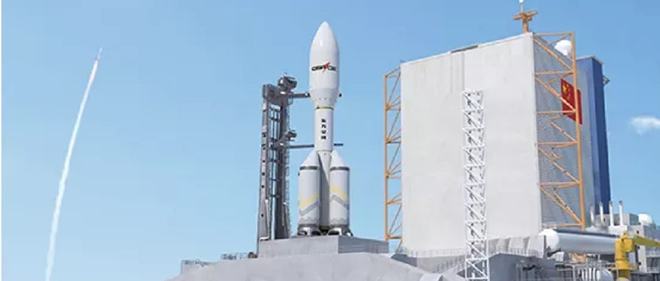In the first quarter of this year, financing in China’s commercial aerospace sector ushered in a good start. According to statistics, in the first quarter of 2022 (January-March), at least 21 commercial aerospace companies in China announced that they had received financing, with a total public amount exceeding 3.73 billion yuan.
Although this amount does not seem to be large, in the whole year of 2021, according to the data of Tianyancha, there are only 37 commercial aerospace financings in my country with a total of more than 6.45 billion yuan. Based on this year’s forecast, commercial aerospace financing in 2022 may double from 2021.
▲In the first quarter of 2022, domestic commercial aerospace companies will obtain financing
Some of these commercial aerospace companies that have received financing are still concentrating on research and development, and some have already successfully launched. Through the recent financing, let’s discuss the latest status and trends of different sub-segments in the commercial aerospace field.
1. More than 20 companies have raised financing, and rocket-related manufacturers account for half of them
The aerospace industry chain system is complex. The upstream enterprises in the industry chain are mainly satellite manufacturing enterprises, the midstream enterprises are mainly rocket production and launch-end enterprises, and the downstream enterprises are mainly satellite application and operation enterprises.
▲Industrial chain of commercial aerospace enterprises
According to our statistics, from January 1 to March 31, 2022, at least 21 commercial aerospace companies in China received financing. A large part of them belong to the upstream and midstream links of the commercial aerospace industry chain. These enterprises belong to the sub-tracks of satellite overall manufacturing, rocket supporting manufacturing, and rocket overall manufacturing.
There are 11 overall satellite and rocket manufacturing enterprises, of which 7 are mainly engaged in the overall rocket manufacturing business, 2 are satellite overall manufacturing enterprises, and 2 are engaged in the R&D and manufacturing of satellites and spacecraft.
Among the 21 companies, 3 companies are mainly engaged in the research and development of rocket supporting engines, materials and structural parts, and 6 companies are engaged in the technology and product development of satellite-related applications such as satellite Internet.
From the perspective of establishment time, 20 of the 21 companies were established after 2015, and only one was established in 1998. In fact, since 2014 and 2015, China has gradually begun to vigorously develop commercial aerospace. Especially in 2015, the National Development and Reform Commission, the Ministry of Finance, and the National Defense Science, Technology and Industry Bureau jointly issued the “National Civil Space Infrastructure Medium and Long-term Development Plan (2015-2025)”. This plan has had an important impact on the development of China’s commercial aerospace industry.
From the perspective of the location of the enterprises, 6 of these 21 enterprises are Beijing enterprises, and the establishment of Beijing enterprises is relatively early. In addition to these companies that received financing this time, there are many commercial aerospace companies in Beijing. In 2020, Beijing released the “Beijing Action Plan for Accelerating New Infrastructure Construction (2020-2022)”, proposing to build a commercial aerospace industry ecosystem covering rockets, satellites, ground terminals, and application services.
The total financing amount of 21 companies exceeded 3.7 billion yuan (some companies did not disclose the specific amount). Among them, the largest single financing amount is the Science and Industry Space affiliated to the Second Research Institute of China Aerospace Science and Industry Corporation, and this (A round) financing is 800 million yuan. Science and Industry Space was established in Hubei in 2017, mainly to carry out space engineering technology research, including communication and remote sensing satellites, and low-cost manned spaceflight technology.
2. Many companies benchmark SpaceX, and intelligent technology builds aerospace equipment
Looking at the commercial aerospace companies that are now strong in the international market, they often have years of commercial aerospace practice. For example, Musk’s SpaceX was established in 2002, and Blue Origin, a commercial space company owned by Amazon CEO Jeff Bezos, was established in 2000. They have successfully launched many rocket missions and even won NASA (NASA) manned spaceflight program, tested commercial space travel missions.
In comparison, China’s commercial aerospace companies started a little later, especially private commercial aerospace companies. Huang Zhicheng, an aerospace technology expert, once said in an interview with the media: “Most of China’s private aerospace companies were established after 2015, and the establishment time is relatively short.” However, in terms of technology, domestic companies have been catching up.
1. The overall rocket manufacturing enterprise: focus on liquid reusable rockets
Among the 21 companies that announced financing from January 1 to March 31, 2022, the largest number of companies are rocket manufacturing companies. Among the overall rocket manufacturing companies, two companies have received the most financing rounds: Tianbing Technology in Tianjin and Interstellar Glory in Beijing. Both companies have received 8 financings since their establishment.
Rockets are the most important vehicles for humans and satellites to travel to and return to space, but the cost of manufacturing rockets is currently high. SpaceX founder Musk once mentioned that the manufacturing cost of the fully reusable two-stage super-heavy launch vehicle Starship (Starship) they developed is several million dollars. The cost of satellites is lower, like SpaceX’s Starlink satellites, which cost less than $500,000 per unit.
Affected by a series of factors such as manufacturing costs, there are more stars and fewer arrows in the commercial aerospace field, and stars are cheap and expensive. The market has a great demand for low-cost, energy-producing, and reusable launch vehicles.
2. Satellite overall manufacturing enterprises: Is intelligent manufacturing also used to build satellites?
Among the 21 companies that announced their financing from January 1 to March 31, 2022, Zhejiang satellite manufacturing company Seth Basis was established in January 2021, focusing on ultra-low orbit satellites and constellation space. Systems and ground systems development. The financing amount of Seth Basis this time exceeded 100 million yuan.
Satellites are an important part of space infrastructure. Space infrastructure is divided into three types of systems: satellite remote sensing systems, satellite communication broadcasting systems, and satellite navigation and positioning systems.
▲A typical representative of satellite navigation and positioning system: Beidou satellite navigation system
Each type of system is composed of space systems and ground systems. Space systems refer to various satellites, while ground systems refer to ground receiving stations, data centers, and other devices that support satellite-to-ground services.
Seth Basis has completed the design of the ultra-low orbit satellite and is planning to make the first test satellite. Ultra-low orbit satellite communication has small delay, high resolution of remote sensing, and fast response, which has advantages in natural disaster survey and space environment research. In the industry, few ultra-low-orbit satellites have successfully conducted in-orbit tests. Currently, there are GOCE satellites of the European Space Agency and SLATS satellites of the Japan Aerospace Exploration Agency.
3. Rocket and satellite manufacturing enterprises: liquid and recyclability are the key words
The choice of aerospace materials is very important in the design of rockets and satellites. Aerospace materials must be resistant to high and low temperatures, aging and corrosion. In the process of commercial aerospace development, related aerospace material companies have also received more attention from capital.
For example, Aisida Aerospace, a Tianjin-based company, announced on January 25 that it had received hundreds of millions of RMB in Series A+ financing. Established in 2018, Aisida Aerospace specializes in the research and development of high-performance composite materials in aerospace and other fields, and has developed supporting components such as launch vehicle fairings, satellite components, ground supporting products and other aerospace components.
4. Satellite Internet companies: two rounds of financing within half a year of establishment
SpaceX can be said to have led many trends in the commercial aerospace field, one of which is satellite Internet, which uses satellites to provide network services for people who are inconvenient to access the terrestrial Internet. HiStarlink, a manufacturer of satellite laser communication equipment, revealed that the company’s products are on-board communication technology for the star chain, and it mainly develops low-power miniaturized spaceborne laser communication terminals and core devices. Just got 2 rounds of financing. The two financings are the angel round financing on December 1, 2021 and the angel + round financing on January 7, 2022. However, no specific amount was disclosed for either financing.
In the satellite Internet, communication signals need to be received by ground terminals, such as ground antennas, communication terminals, and so on. Founded in 2017, Ruosen Smart is a ground terminal manufacturer that received strategic financing in January. Ruosen Intelligent mainly develops phased array satellite Internet terminals based on metamaterials to meet the broadband satellite communication needs of marine navigation, aircraft aviation and other application scenarios.
3. Driven by SpaceX and other companies, global commercial aerospace is even hotter
When it comes to commercial spaceflight, we have to mention the three commercial space companies that have aroused heated discussions among the public from last year to this year, SpaceX, Blue Origin and Virgin Galactic. They have successfully completed the first commercial space travel mission in various senses one after another, igniting people’s dream of space travel again. Because of its outstanding progress in the commercial aerospace field, SpaceX’s market value also reached $100 billion last year.
At the same time, some international commercial aerospace companies have received financing, such as the Finnish synthetic aperture radar satellite operator Ice Eye, which announced on February 3 that it has completed a $136 million Series D financing.
Official financial support from various countries (regions) has also been continuously given to aerospace companies. In January this year, the European Commission announced to provide early financial support to European aerospace companies, hoping to retain European aerospace startups.
The commercial aerospace field is still a relatively new field. Although the cosmic space is large, the current technological scope of human beings is still around the earth, and the spectrum and orbital resources are still relatively limited. With the international commercial aerospace companies such as SpaceX promoting a large number of commercial aerospace projects and the development of China’s commercial aerospace industry, the commercial aerospace competition in China and the world will become more intense in the future.




GIPHY App Key not set. Please check settings